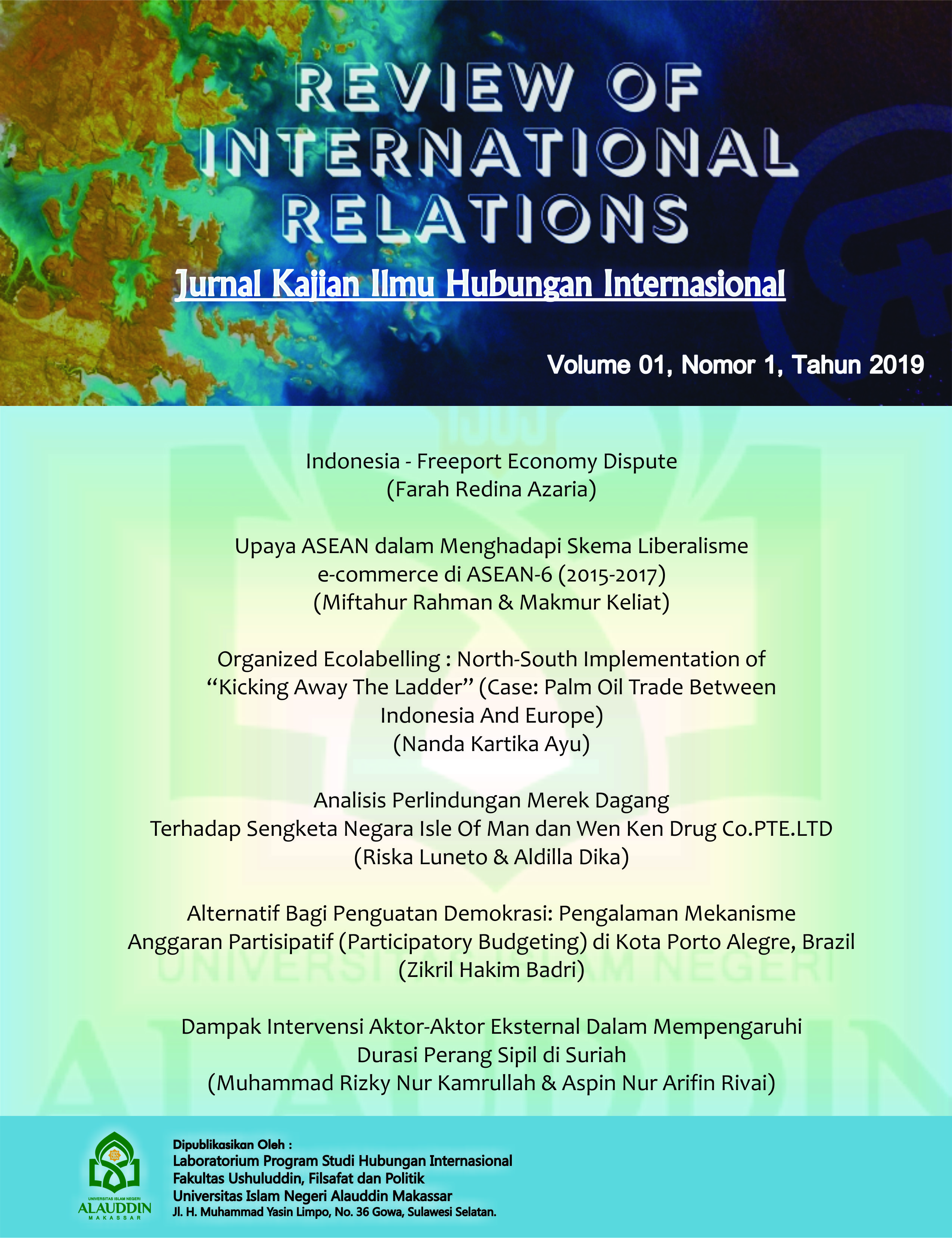UPAYA ASEAN DALAM MENGHADAPI SKEMA LIBERALISASI E-COMMERCE DI ASEAN-6 (2015 – 2017)
Abstract
This study discusses about digital era marked by the advancement of knowledge and innovation in the field of Technology, Information and Communication (ICT) which has provided major changes to all aspects of life, especially in economy. ASEAN as a regional cooperation in the Southeast Asia region, currently as an emerging market in e-commerce competition, especially for Singapore, Malaysia, Thailand, Indonesia, the Philippines and Vietnam (ASEAN-6). Based on this phenomenon, my research question is, how are ASEAN-6's efforts in facing of e-commerce liberalization in the digital era in line with the ASEAN framework (AEC Blueprint 2015 & 2025, ASEAN ICT Masterplan and ASEAN Digital Integration). This research use the theory of trade liberalization, the concept of economic integration and the concept of digital economics to be able to examine the phenomenon of e-commerce liberalization in ASEAN-6. The various literature reviewed by the author shows that the growth of e-commerce is influenced by four factors, namely: 1) internet infrastructure; 2) electronic payment system; 3) shipping services that has a wide coverage; 4) government policy framework in each ASEAN-6 country. In addition, there are several obstacles found including: 1) the geographical location of each ASEAN-6 country that affects the process of developing the internet infrastructure; 2) issues of personal data protection and cyber security related to electronic payment systems; 3) effectiveness and efficiency of the existence of shipping services, especially shipping between countries; and 4) policy discrepancies between countries. This study concludes that as a regional organization in Southeast Asia, ASEAN continues to strive to harmonize regulations among member countries, form a framework of cooperation and other agendas to be able to harmonize the development of ICT, especially the growth of e-commerce. The fundamental difference from this study with previous studies is that there have been no studies that examine e-commerce liberalization in the ASEAN region, so the author tries to collaborate on several facts related to the growth of e-commerce liberalization in ASEAN-6
Keywords: ASEAN, e-commerce, digital economy, economic integration
Downloads
References
ASEAN. (2000, December 11). Retrieved from e-ASEAN Framework Agreement: https://asean.org/?static_post=e-asean-framework-agreement
ASEAN. (2019, May 24). ASEAN Telecommunications and IT Ministers Meeting (TELMIN). Retrieved from https://asean.org/asean-economic-community/asean-telecommunications-and-it-ministers-meeting-telmin/
ASEAN Secretariat. (2015). ASEAN ICT Masterplan 2015 Completion Report. ASEAN, ASEAN Secretariat, Jakarta. Retrieved Mei 20, 2019, from https://www.asean.org/storage/images/2015/December/telmin/ASEAN%20ICT%20Completion%20Report.pdf
ASEAN Secretariat. (2016). ASEAN Economic Community at a Glance. Jakarta: The ASEAN Secretariat.
ASEAN Secretariat. (2017). ASEAN Economic Integration Brief. Jakarta: ASEAN.
ASEAN.org. (2019). ASEAN Ditigal Integration Framework. Retrieved Mei 20, 2019, from asean.org: https://asean.org/storage/2019/01/ASEAN-Digital-Integration-Framework.pdf
Baker McKenzie. (2018, September). New draft Personal Data Protection Bill issued for public hearing - Substantial changes following GDPR. Retrieved May 29, 2019, from Baker McKenzie Thailand; Client Alert: http://bakerxchange.com/cv/c5e848a9f09ae47460c31fdecfa434ae69ed0b63
Balassa, B. (1961). The Theory Of Economic Integration. Greeedwood Press.
Baldwin, R. E., & Kay, D. A. (1975). International Trade and International Relations. International Organization, Vol. 29, No. 1, World Politics and International Economics, 99-100.
Capgemini & BNP Paribas. (2018). World Payment Report 2018. Capgemini.
Chandler, D. (2009). The Global Ideology: Rethinking the Politics of the 'Global Turn' in IR. Journal of International Relations, 535.
Ecommerce Germany. (2019). Leading Marketplaces in Asia. Retrieved Mei 2019, from Ecommerce Germany News: https://ecommercegermany.com/blog/16-leading-marketplaces-asia
Florian Hoppe, T. M. (2018, June 08). Advanciing Towards ASEAN Digital Integration. Retrieved from Bain & Company: https://www.bain.com/insights/advancing-towards-asean-digital-integration/
Gilpin, R. (2001). Global Political Economy: Understanding The International Economic Order. New Jersey: Princeton University Press.
Google & Temasek. (2016). e-Conomy SEA - Unlocking the $200 billion digital opportunity in. Google & Temasek.
Google & Temasek. (2016). e-Conomy SEA: Unlocking the $200B digital opportunity in Southeast Asia. Google & Temasek. Retrieved June 15, 2019
Indotelko. (2017, December 25). Pemerintah ungkap tantangan pembangunan infrastruktur internet. Retrieved from Indotelko: https://kominfo.go.id/content/detail/12182/pemerintah-ungkap-tantangan-pembangunan-infrastruktur-internet/0/sorotan_media
Kauppi, P. R. (2009). Interntional Relations and World Politics: Security, Economy and Indentity. New Jersey: Pearson International Edition.
Kemnkeu. (2018, Maret). Media Keuangan. Kesetaraan Pajak Untuk E-Commerce, XIII.
Luo, C. (2018, September 5). E-commerce IQ. Retrieved from Understanding the Upcoming and Current Tax Regulations on Ecommerce in Southeast Asia: https://ecommerceiq.asia/tax-regulations-ecommerce-southeast-asia/
Prawironegoro, D. D. (2006). Ekonomi Politik Globalisasi (Kajian Ekonomi Politik, Filsafat, dan Antropologi). Diadit Media.
Rudy, T. M. (2003). Hubungan Internasional Kontemporer dan Masalah-masalah Global. Bandung: PT. Refika Aditama.
Tapscott, D. (1997). The Digital Economy (1st ed.). McGraw-Hill.
Tapscott, D. (2015). Twelve Themes of The New Economy. In D. Tapscott, The Digital Economy (pp. 54-77). McGraw-Hill.
Winarno, B. (2008). Globalisasi; Peluang atau Ancaman bagi Indonesia. Penerbit Erlangga.
World Bank. (2019, May 19). TCdata360. Retrieved from Country rank and value in the ITU ICT Development Index: https://tcdata360.worldbank.org/indicators/h2e1ddd20?country=IDN&indicator=24719&countries=SGP,MYS,THA,VNM,PHL&viz=bar_chart&years=2015&indicators=944
Yanai, A. (2004). Characteristic of APEC trade liberalization; A compare analysis with the WTO. In J. Okamoto, Trade Liberalization and APEC (p. 11). London and New York: Routledge.










